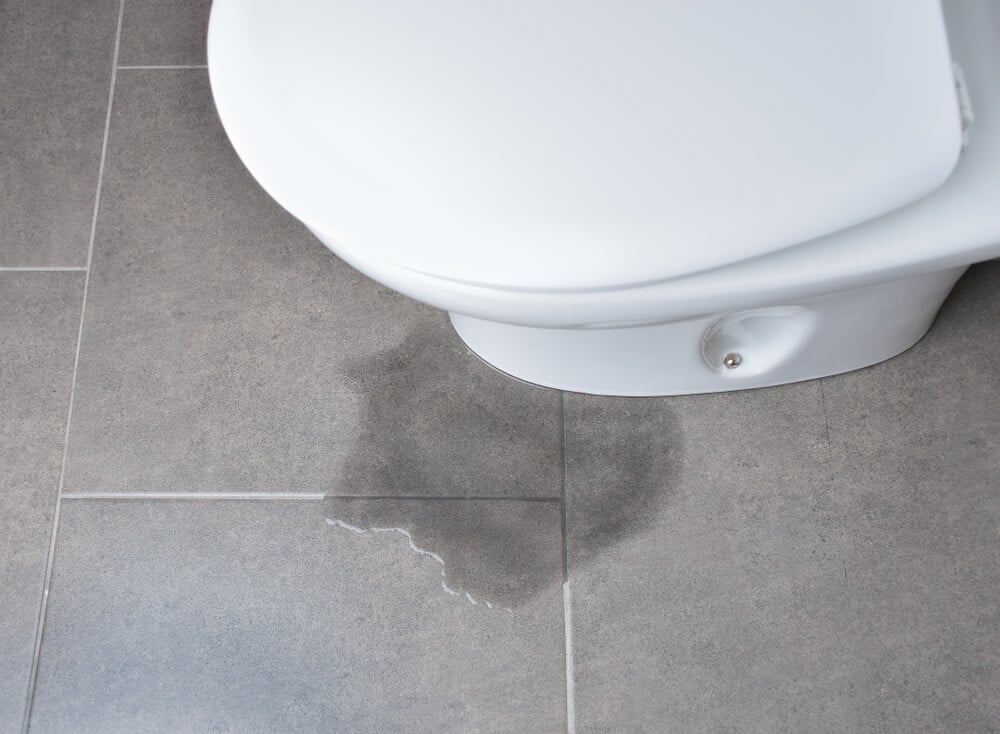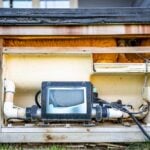
You Have a Ceiling Leak – The Reasons It’s Happening and What You Can Do About It
- By: Amer ZaghloulehUncategorizedComment: 0
You shouldn’t ignore any leak, but some can be more serious than others. Water dripping from the ceiling might be the most problematic. It can compromise the structural integrity of your abode and lead to various health problems.
But why does a ceiling leak happen? Also, how should you address the issue?
What Is the Cause of Dripping Water From Ceiling?
Like any other leakage, a ceiling leak is hard to troubleshoot. It can be caused by a large number of issues. Here are the most probable culprits.
Roof Leak
The most common reason people’s ceilings leak is that they have a leaky roof. The attic could be poorly ventilated, and the shingles might be broken. There may also be other issues with roof components, such as deteriorated vents and chimneys.
Leaky roofs enable rain, snow, and other elements to enter your house. They end up in the attic, where moisture is trapped and soaks through to the ceiling.
Roofs can suffer heavy damage all year long, which is why you should examine the structure regularly. Look for the following signs of roof leaks.
- Damaged or cracked shingles
- Damaged or missing boot covers or flashing
- Wet decking and water spots visible from the attic
Most of these take place in the winter when roof damage is most evident. This period is characterized by extreme temperature fluctuations. The outside air keeps freezing and thawing snow on your roof, creating ice dams beneath the shingles. The barriers can enable huge amounts of water to penetrate your dwelling. Left unchecked, they can result in ceiling leaks.
Burst Pipes
Another reason you might have a ceiling leak is burst pipes. They can bring about massive damage, and like roof leakage, they normally happen during winter.
The temperatures inside the pipes plummet, making water cool down rapidly. This process causes the liquid to expand and puts the piping under immense pressure. If freezing conditions persist, the pipes can handle no more stress, and they crack.
Burst piping often results in heavy flooding and affects all parts of your home, including the ceiling. Some areas at higher risk of bursts are lines upstairs leading into your bathroom or laundry room.
A great way to tell if you’re dealing with burst pipes is to check the color of the water on your ceiling. If it’s lighter or nearly transparent, you most likely have a cracked pipe. The liquid is so clear because it’s been filtered.
Water Leak Through Ceiling Due to Faulty Appliances
Besides a ceiling leak from rain, you might also face ceiling leakage caused by a faulty appliance. You should only consider this possibility if your house has a second floor with dishwashers, refrigerators, clothes washers, and similar machines.
The drain and supply lines of the appliances deteriorate over time. They develop cracks that allow water to seep into the surface under the machines. The moisture soaks the floor, wreaking havoc on your ceiling beneath.
You can detect this ceiling leak by examining the area behind or under your appliances. If the water is clear, you might need to replace the machines.
Toilet Leaking Through Floor and Other Plumbing Problems
A variety of plumbing scenarios can lead to ceiling leaks.
- Toilet leaking through floor
- Toilet leaking through ceiling directly
- Toilet leaks through ceiling when flushed
- Broken seals and gaskets
- High water pressure
- Water leaking from ceiling under bathroom
- Leaks from the washer

Condensation Inside the House
Your home may not be properly insulated or ventilated. Your humidifier might also be set too high, allowing condensation to accumulate and cause moisture. The moisture ends up in the attic or other parts of your home, increasing the risk of ceiling leakage.
After noticing condensation, you need to determine the cause. Many activities can raise humidity levels.
- Ironing damp clothing or steam ironing
- Drying your clothes indoors
- Boiling liquids
- Wet/dry vacuum cleaners
- Tumble drying while ventilation isn’t working
- Bathing or showering
- Decorating or stripping wallpaper using water
Clogged Gutters and Downspouts
Your gutters and downspouts can only process so much dirt and debris before they get clogged. Eventually, twigs and leaves prevent water from flowing away from your house. The moisture has nowhere to go but inside. Left unchecked, this can easily result in ceiling leakage.
How to Find Leak in Wall or Ceiling
If you’re dealing with a ceiling leak, you need to find the source. To do so, you should first visit the attic. Perform a visual scan to find clues about the location of your leak. Check for any water damage on your roof’s underside. The wood could be darker than usual and have mold on some of the sections. If so, your leakage was probably caused by a roofing problem.
Tracking down your leak is harder if your attic has insulation. You’ll need to approach the approximate location and pull it away from the surrounding surface. Besides the ceiling, you may need to strip the insulation from the wall or floor to detect water damage.
If you have pipes near the leak, inspect them for corrosion or damage. Worn lines usually have holes, cracks, and other signs of deterioration.
Sometimes, you might need to dig a little deeper to diagnose a broken pipe. Feel it for moisture and look for green patina, rust, or other conditions associated with moisture damage. If necessary, inspect the line with a flashlight to find out if it leads to your ceiling.
If you can’t see any pipes in your attic, the most likely cause of your ceiling leak is a hole in your roof. Apart from the underside, you should examine the sections around your vents, chimneys, and skylights. These are especially prone to cracks and more likely to bring about ceiling leakage.
If you discover a hole, you can make the repairs easier for yourself or professionals by sticking a straw through it. This allows for easier detection from outside the house.
How Do You Address Ceiling Damage From Roof Leak or Other Culprits?
The safest way to remedy a ceiling leak is to hire an experienced ceiling leaks repair team. They have all the tools and skills to restore the surface to its former condition and address the following issues.
- Bathroom leaking through ceiling
- Water leak in ceiling below bathroom
- Ceiling damage from roof leak
Attempting to fix the problem on your own is ill-advised. However, here’s what you can do if you’re confident about your abilities.
Stabilize Your Situation
Whether you’re fixing a ceiling leak yourself or waiting for a plumber, you can keep the harm from spreading to the rest of the place by taking action to minimize the damage.
- Rearrange furniture to avoid dripping water
- Remove cherished or valuable possessions from the site
- Cover walls and floors with a tarp, garbage bags, or other waterproof materials
The next thing you can do is to soak up lingering water from your floor before placing a waterproof cover. This prevents moisture from sticking to the surface and increasing condensation. If the leak is coming from your roof and dripping down your walls, apply plastic barriers to your walls to curb mold growth.
If your ceiling is bulging or dripping due to high amounts of water, protect the surrounding surface with a tarp. Then, poke a hole in your ceiling to release the pressure and safeguard against drywall damage.
Finally, place a container (e.g., bucket) under your leak to catch the falling water. Be sure your container is surrounded by a plastic cover. Also, keep an eye on the area to prevent overflows. If you leave it unattended for a few minutes, it can fill up before you know it.
Create a Barrier in Your Attic
If you can safely access your attic, climb up and turn on your flashlight. As previously discussed, you can track down the source of the leak by following signs of moisture.
However, the water may not travel as expected. Rather than following a straight line, the moisture can race from the affected area downward toward the closest joint. From there, it looks for escape routes, where it can develop a ceiling leak. This is usually the weakest spot of your fixture opening (vent and ceiling lamps) or drywall.
Finding the culprit can take time, but it should tell you where moisture is entering your house. More importantly, it lets you create a barrier to prevent more water from reaching your ceiling.
Building a barrier shouldn’t be too difficult. You need only place some plywood on the joists and put a container on top of it to collect dripping water. Be careful not to place your bucket directly on your drywall between the beams. Otherwise, it can break the plywood when it becomes heavy with water. Regularly empty the container until a professional arrives or you fix the problem.
Use a Funnel to Redirect Leaking Water
If you want to avoid having to keep an eye on buckets or other containers, you can switch to bottle funnels. These can help you redirect moisture outside your house and prevent the ceiling from absorbing more water. You can use the solution inside the dwelling (where your ceiling is leaking). Still, you’re best off applying it within your attic to mitigate water damage throughout the house.
Take the following steps to build a DIY bottle funnel.
- Find a large bottle or plastic jug.
- Cut the item in half to create a bottleneck and wide opening.
- Find a hose that can reach from the source of the leak to the closest exit (e.g., window).
- Get some duct tape or other strong adhesive. Secure the hose to your bottleneck.
- Place the wide opening over your leak and fasten it with duct tape.
- Pull the bottleneck to a nearby door or window to enable water to flow through your hose and away from your home.
Take Care of Any Fallen Branches
Your ceiling leak might have been caused by a fallen tree limb. It allows rain and snow to enter your place and create leakage. In this case, you’ll need to remove the debris while making sure you don’t damage the area underneath. You’ll also need to patch up any holes left by the branch.
If the limb is too large, don’t try to relocate it on your own. Instead, break down the branch into smaller bits with a chainsaw. Again, you shouldn’t perform this job if you’re inexperienced.
The same holds if you can’t remove the branch without destabilizing the roof or causing further damage. If so, cover the surface with a tarp to keep more moisture from reaching your ceiling.
Dry the Affected Area
When addressing the source of your ceiling leak, you should allow the damaged materials to dry thoroughly. The surface around and above your ceiling cavity is especially important. If any moisture gets trapped behind your drywall, the chances of developing mold are extremely high.
Minor leakage may resolve itself, but that’s not the case with larger leaks. They generally require you to open up a part of your ceiling and remove moisture with a dehumidifier or fan.
Repair Your Ceiling
The most reliable way of fixing your ceiling is to book trained contractors. Apart from safety hazards and any existing warranties (perhaps your roof is still under warranty), you may need to do a wide range of projects.
Depending on your leak, you may need to simply touch your ceiling up slightly with some spackle and paint. In other cases, replacing and repainting your entire ceiling may be necessary.
The most common fix is to remove moist drywall and replace it with new material. This way, you’ll be able to reach ceiling joists, allowing you to hang patches more easily.
Painting the area is also simpler if you can access the joists.
Struggling How to Find Leak in Ceiling or Fix It? Leave the Work to Experts
Few homeowners are skilled enough to repair a ceiling leak. And why should you risk your well-being and potentially cause more damage when you can outsource the job to a professional? You can hire a reputable team, such as Anytime Plumbing.
Our contractors can address a wide array of plumbing problems, including the causes of your ceiling leaks. Call 831-431-6593 for more information about our services.







